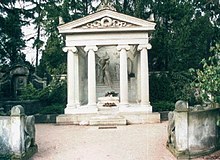Paul Ziller (architect)
Paul Friedrich Ziller (born May 30, 1846 in Oberlößnitz ; † March 11, 1931 in Radebeul ) was a German neoclassical architect who designed for his eldest brother Ernst Ziller in Greece for about 25 years . He was the youngest brother of the Radebeul brothers Moritz and Gustav Ziller and, like them, came from a family of builders in Saxony .
Life
Ziller was born as one of ten children of the Radebeul master builder Christian Gottlieb Ziller (1807–1873). After an apprenticeship as a stonemason from 1860–1862, he studied architecture , probably in Dresden .
After his military service in 1868 he went to his eldest brother Ernst Ziller in Athens , where he designed houses and interior furnishings as his assistant for the next 25 years.
In the mid-1890s (after May 1895) Ziller returned to Saxony and settled in Kötzschenbroda in 1897 , where he lived with his unmarried sister Pauline (1845-1937) at Dresdner Strasse 1 (presumably: Meißner Strasse 157). Since he is not listed in the list of all traders in the Lößnitz address books in 1897 and 1899 under the headings of builders or architects , it is assumed that he first worked in his brothers' construction company. In 1901 he briefly took over the management of the Ziller brothers' construction company for his older brothers Moritz and Gustav, who had died in the meantime, and after a short time passed them back to his sister-in-law Marie, Gustav's widow. Paul Ziller opened a construction office in Serkowitz in October 1901 at Rosenstrasse 8, from 1903 under the name “Bureau for Architecture, Construction and Repair Work”, which he advertised in the address book of his time (then at Rosenstrasse 20) in 1915.
In 1910, Ziller was awarded the Silver Cross of the Order of Savior for his services to the Greek state .
In 1907 he moved his business and apartment to Rosenstrasse 20, where he again spent the last years of his life in relative poverty with his sister Pauline. He was buried in the Radebeul-Ost cemetery.
Factory (monuments in Radebeul)
The buildings listed below are in the monument topography of the Federal Republic of Germany . Monuments in Saxony: City of Radebeul listed cultural monuments . They are therefore not a complete catalog of works .
Paul Ziller most important work on German soil is the tomb of Karl May in the cemetery Radebeul-Ost , which he in 1903 as a family burial place of the family May and Plöhn strongly inspired by the Athens Nike temple designed, also affected by the grave monument to Heinrich Schliemann his brother Ernst Ziller in Athens.
- 1904: Renovation of Villa Käthe in Niederlößnitz , Zillerstraße 7 (built in 1889 by the Ziller brothers, probably designed by Carl Käfer )
- 1904: Conversion of Villa Zillerstraße 11 in Niederlößnitz (built in 1876 by the Ziller brothers)
- 1905: Design Villa Franziska in Oberlößnitz , today Radebeul, Hoflößnitzstraße 58
- 1906: Reconstruction and expansion of Landhaus Friedlandstrasse 1 in Serkowitz , today Radebeul (built in 1880 by the Ziller brothers)
- 1908: Renovation and expansion of Landhaus Mehlhorn in Niederlößnitz, Paradiesstraße 48 (design by Georg Heinsius von Mayenburg )
- 1908: First draft at Weinbergstrasse 32 in Oberlößnitz, rejected by the Saxon Heritage Protection Association
- 1910/1911: Extension of Villa Waldhof in Niederlößnitz, Paradiesstraße 46 (built in 1862 by Moritz Ziller )
- 1911: Terrace extension to Villa Tanger in Kötzschenbroda, Meißner Straße 159 (built in 1873 by the Ziller brothers)
- 1916: Extension of Villa Louise Maria Koch in Niederlößnitz, Borstrasse 14
- 1919: Extension of Villa Margarethe in Alt-Radebeul , Clara-Zetkin-Straße 1
literature
- Frank Andert (Red.): Radebeul City Lexicon . Historical manual for the Loessnitz . Published by the Radebeul City Archives. 2nd, slightly changed edition. City archive, Radebeul 2006, ISBN 3-938460-05-9 .
- Volker Helas (arrangement): City of Radebeul . Ed .: State Office for Monument Preservation Saxony, Large District Town Radebeul (= Monument Topography Federal Republic of Germany . Monuments in Saxony ). SAX-Verlag, Beucha 2007, ISBN 978-3-86729-004-3 .
- Friedbert Ficker , Gert Morzinek, Barbara Mazurek: Ernst Ziller - A Saxon architect and building researcher in Greece. The Ziller family . Kunstverlag Josef Fink, Lindenberg i. Allgäu 2003, ISBN 978-3-89870-076-4 .
- Gert Morzinek: Historical forays with Gert Morzinek . The collected works from 5 years “StadtSpiegel”. premium publishing house, Großenhain 2007.
Web links
- Topping-out ceremony at the May tomb . At the bottom left of the photo is Paul Ziller with his coat on his arm.
Individual evidence
- ^ Karl May's tomb in Radebeul
- ↑ a b According to the address book of Dresden and suburbs. 1915. Part VI, p. 443.
- ↑ The Ziller brothers in the Karl May Wiki
- ^ Information from the Radebeul city archive to users: Jbergner from February 9, 2009
- ^ Obituary from May 14, 1931
- ↑ Volker Helas (arrangement): City of Radebeul . Ed .: State Office for Monument Preservation Saxony, Large District Town Radebeul (= Monument Topography Federal Republic of Germany . Monuments in Saxony ). SAX-Verlag, Beucha 2007, ISBN 978-3-86729-004-3 , p. 332 .
| personal data | |
|---|---|
| SURNAME | Ziller, Paul |
| ALTERNATIVE NAMES | Ziller, Paul Friedrich (full name) |
| BRIEF DESCRIPTION | German neoclassical architect |
| DATE OF BIRTH | May 30, 1846 |
| PLACE OF BIRTH | Oberloessnitz |
| DATE OF DEATH | March 11, 1931 |
| Place of death | Radebeul |

